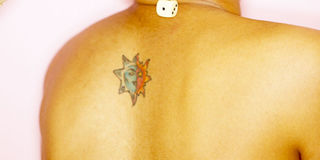The good, the bad and the ugly of body art

PHOTO | AFP
Tattooing has become the in-thing among young Kenyans in the last decade and is continuing to grow in popularity.
However, as an art form, it has been in existence for centuries, with records going as far back as 1300BC when various Polynesian and Japanese tribesmen decorated their skin to show their allegiances.
And in the 1800s, famous figures who appreciated the art form included King George V of England who had a large dragon tattooed on his arm while Winston Churchill’s mother Clementine had a snake tattooed on her wrist.
Permanent markings
The first tattoo machine, an electronic hand-held tool used to make permanent markings on the skin using indelible ink, was patented in 1891 by an Irish-American tattooist named Samuel O’Riley in New York. It was made of two strands of wire coiled around an electrically driven iron core.
Modern variations to this early model now allow tattooists to control needle depth, speed and force of application. And, as the art becomes more precise, more and more Kenyans are bearing the pain to get the satisfaction of self-expression.
Martin Ndomo has had 10 tattoos done on his body.
“It used to hurt but, with time, I stopped caring about the pain. The end product is sweeter,” the Kimathi Street movie retailer and environmental health and sports science university graduate says.
He has a goth tattoo because he “loves rock music”, a Chinese pictogram that stands for “God help us” and several erotic tattoos because “ladies love them”.
A tattoo begins with initial piercing to form an outline; then additional puncturing to fill in the outline follows.
Despite the pain associated with tattooing, 27-year-old tattoo artist George Mali is never short of clients in his Norwich Union tattoo parlour, Afshon.
“I tattoo more than 10 designs in a day,” he said.
The Afshon Tattoo Parlour in Norwich Union House is a simple office with a laptop, a desk with several plastic containers that hold tattooing ink, tattoo machines and needles, disinfectants and tattoo art wallpaper on the walls.
Tattoos were not always popular in Kenya, as tattooists at Tattoos by Nick attest. Despite starting out seven years ago, they only got a proper shop that meets their needs two years ago.
“Nick moved around town for five years looking for a place he would be warmly accepted. Two years ago he found that place in Westlands,” Edward Gachikwa, a tattoo artist at the parlour, says.
But these days, tattoo parlours are everywhere and business is booming. Lifestyle conducted an informal survey of 25 tattoo parlours in Nairobi and surrounding areas.
We found that an average of four people a day are tattooed in each parlour, and eight in 10 of them are women aged between 19 and 35. In the 18-25 year bracket, nine out of 10 are college and university students.
Celebrities are among the ranks of the tattooed. Former Easy FM radio presenter Talia Oyando has a tattoo on her neck and two on her upper back. One is a musical note. Songbird Kaz has one on her right shoulder of a baby angel.
Rapper Abbas has seven tattoos, including two microphones on his lower arm that represent his voice. Jackson Makini aka Prezzo has one of his late father on his arm.
Tattoos were originally associated with sailors and those outside the social pale. Today even the most straight-laced may have a discreet rose tattooed somewhere on their bodies.
Tattooing has become respectable business in Kenya.
Tess Narita, a local model, says she was influenced by Western celebrities to have tattoos on her body.
“My light skin, and the good work of Georgi (George Mali), were a perfect match. Everybody I have met loves my tattoos,” she said as she unbuttoned her pink blouse to reveal the Chinese love symbol on her chest.
Family members
According to parlour owners, many of the tattoos preferred by Kenyans are portraits of family members, a depiction of Christ on the cross, Latin American guerrilla Ernesto “Che” Guevara, Chinese characters, ships, flowers and erotic images.
But why tattoo your body? The reasons given vary as much as the artwork.
“It’s the only thing that makes me happy in my life,” Martin Odumo said.
Abbas’ tattoos include some in memory of his late parents and his brother who has been missing for the last seven years.
“I am like the last member of my family. All have passed away. I wake up and look at them (tattoos) to remember my family.”
Grace Njoki has tattoos on her lower back and inner thighs. “Men love them, and they make me feel like a sexy and liberated young lady,” the 20-year-old University of Nairobi student said.
And for those engaged in tattooing?
“I am a student of art at Buru Buru Institute of Fine Arts, and I have a keen interest in doing tattoos,” said Frank Kyalo, a 21-year-old who runs Poplink Tattoo Parlour also in Norwich Union.
He does three tattoos a day at his Norwich Union shop and more than six in his Umoja parlour. His clients include ladies who want tattoos done on very personal parts of their anatomy.
The last such client he had wanted roses around her Eve.
Astronomical figures
A simple tattoo costs around Sh1,500, but some pay astronomical figures.
One parlour indicated that a Kenyan female football fanatic paid Sh97,000 to have David Beckham’s face tattooed on her back.
There are no laws in Kenya governing the age at which one may be tattooed. In Britain, the Tattooing of Minors Act 1969 makes it an offence to tattoo anyone under 18, even with parental permission.
The main precautions to take when getting a tattoo done are: ensure the tattoo artist wears gloves, the ink used on you should not be returned to a universal container, and you must see the artist remove new and sterilised needles.
With the lack of legal protection, school children, and even those in their 20s, have tattoos done without thinking about the implications of what they’re doing or why they’re having it done.
Ill-advised hair cuts and nasty piercings can be put right; erasing a tattoo is not that simple. Some people end up having to go for tattoo removal after finding that the tattoos don’t look so good after some time and/or meet disapproval in the workplace or at home.
Last year, a client of Afshon Tattoo Parlour checked into Kenyatta National Hospital (KNH) for tattoo removal.
“Her parents were not happy, and they put a lot of pressure on her,” tattoo artist George said.
There are several methods of tattoo removal including using a cream to draw the ink to the surface, laser removal and skin grafting. Laser removal is the cheapest method and is available in Kenya.
Skin grafting is done at KNH. Laser removal hurts more; it is said to feel like someone is adding salt and spirit to a wound at the same time.




